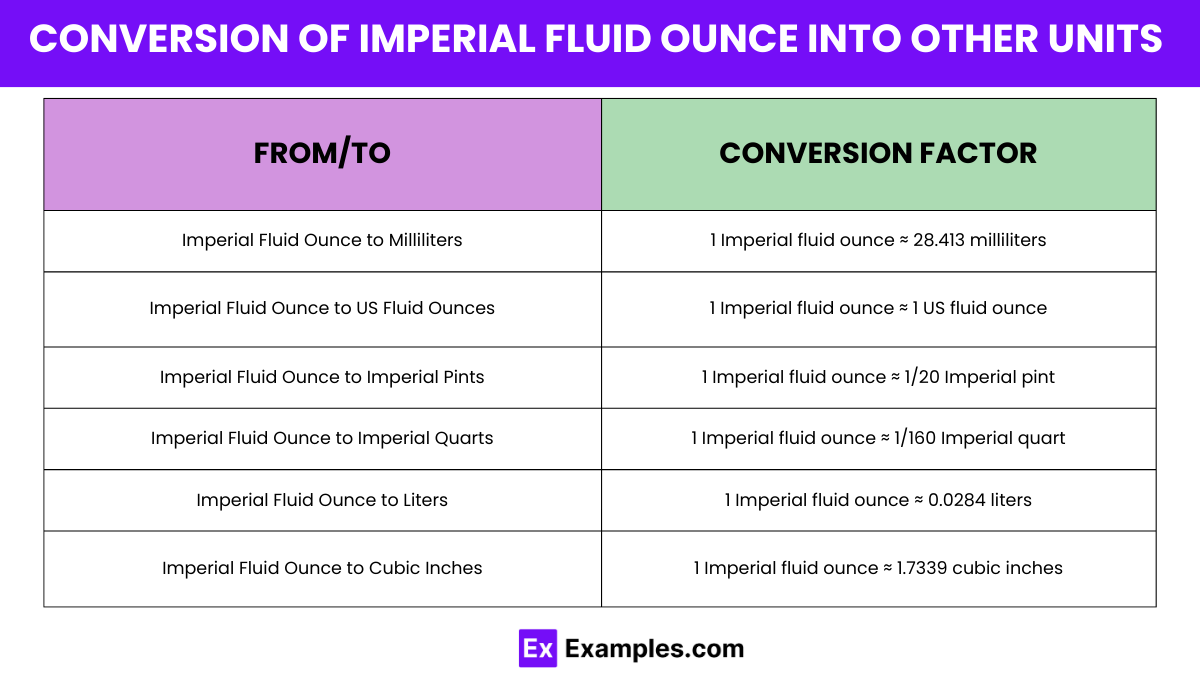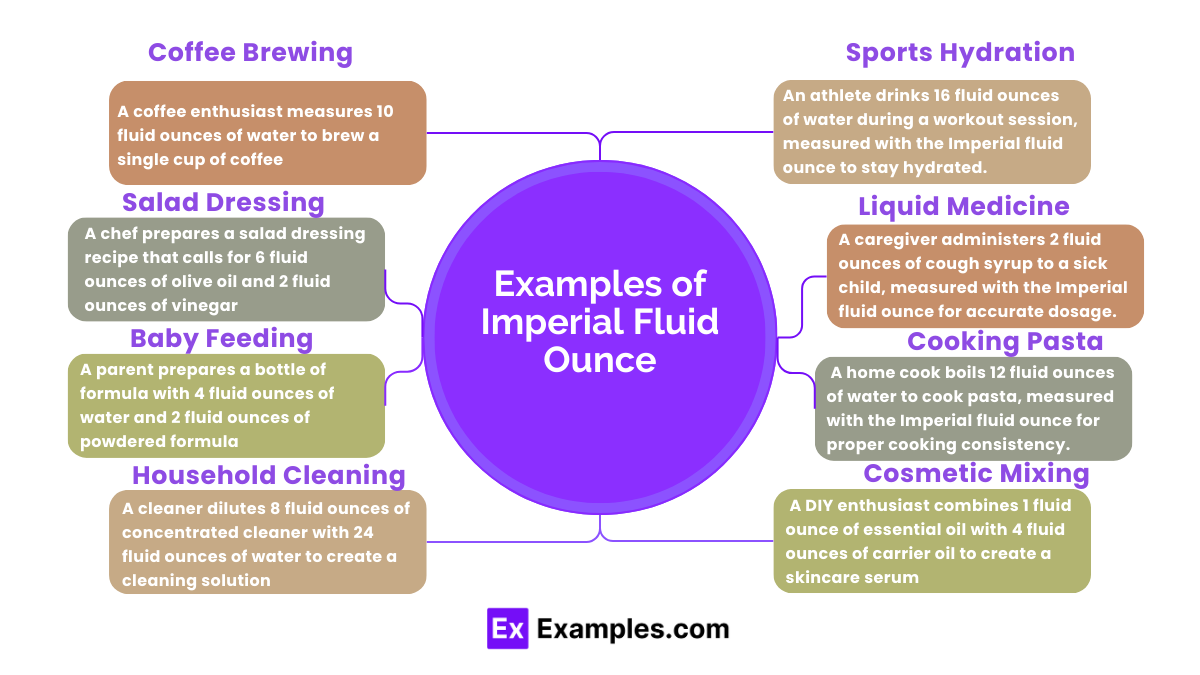What is the basic unit of volume in the Imperial system for liquid measurements?
Liter
Fluid ounce
Gallon
Pint


Recipes often specify ingredients in terms of fluid ounces, necessitating a clear understanding of this unit for accurate measurement. Additionally, the Imperial fluid ounce is utilized in various industries, ensuring precise measurements for consistency and quality in products such as food and beverages. Overall, the Imperial fluid ounce plays a vital role in both culinary and industrial settings within the British Imperial system.

| To Unit | Conversion |
|---|---|
| Milliliters | 1 Imperial fluid ounce ≈ 28.413 milliliters |
| US Fluid Ounces | 1 Imperial fluid ounce ≈ 1 US fluid ounce |
| Imperial Pints | 1 Imperial fluid ounce ≈ 1/20 Imperial pint |
| Imperial Quarts | 1 Imperial fluid ounce ≈ 1/160 Imperial quart |
| Liters | 1 Imperial fluid ounce ≈ 0.0284 liters |
| Cubic Inches | 1 Imperial fluid ounce ≈ 1.7339 cubic inches |
1 Imperial fluid ounce is equivalent to approximately 28.413 milliliters. This conversion is frequently used in scientific and laboratory settings where metric units are preferred.
1 Imperial fluid ounce is slightly larger than 1 US fluid ounce, which is approximately 29.5735 milliliters. This conversion is relevant when comparing measurements between the British Imperial and US customary systems.
There are 1/20 of an Imperial pint in 1 Imperial fluid ounce. This conversion is useful in recipes and culinary applications where quantities are specified in pints.
1 Imperial fluid ounce is equal to 1/160 of an Imperial quart. This conversion is relevant when scaling recipes or when working with larger volumes of liquid.
1 Imperial fluid ounce is approximately 0.0284 liters. This conversion is commonly used in countries that primarily use the metric system for volume measurement.
1 Imperial fluid ounce is equivalent to approximately 1.7339 cubic inches. This conversion is relevant in engineering and construction applications where volume calculations are required.

1.Coffee Brewing: A coffee enthusiast measures 10 fluid ounces of water to brew a single cup of coffee, using the Imperial fluid ounce for precision.
2.Salad Dressing: A chef prepares a salad dressing recipe that calls for 6 fluid ounces of olive oil and 2 fluid ounces of vinegar, measured with the Imperial fluid ounce for balanced flavor.
3.Baby Feeding: A parent prepares a bottle of formula with 4 fluid ounces of water and 2 fluid ounces of powdered formula, measured using the Imperial fluid ounce for proper nutrition.
4.Household Cleaning: A cleaner dilutes 8 fluid ounces of concentrated cleaner with 24 fluid ounces of water to create a cleaning solution, measured with the Imperial fluid ounce for effectiveness.
5.Sports Hydration: An athlete drinks 16 fluid ounces of water during a workout session, measured with the Imperial fluid ounce to stay hydrated.
6.Liquid Medicine: A caregiver administers 2 fluid ounces of cough syrup to a sick child, measured with the Imperial fluid ounce for accurate dosage.
7.Cooking Pasta: A home cook boils 12 fluid ounces of water to cook pasta, measured with the Imperial fluid ounce for proper cooking consistency.
8.Cosmetic Mixing: A DIY enthusiast combines 1 fluid ounce of essential oil with 4 fluid ounces of carrier oil to create a skincare serum, measured with the Imperial fluid ounce for skincare benefits.
These examples illustrate the versatility of the Imperial fluid ounce in various aspects of daily life, from cooking and cleaning to health and wellness.
The US fluid ounce and the Imperial fluid ounce are both units of volume measurement, but they differ in several key aspects:
To convert fluid ounces to volume, multiply the number of fluid ounces by the specific conversion factor for the substance being measured, such as 29.5735 milliliters per US fluid ounce. This process yields the volume in milliliters, allowing for accurate conversions between fluid ounces and other units of volume.
Fluid ounces are predominantly associated with the English measurement system, though they may be encountered in some metric contexts due to historical influences. However, milliliters and liters are the standard units for volume measurement in the metric system.
Text prompt
Add Tone
10 Examples of Public speaking
20 Examples of Gas lighting
What is the basic unit of volume in the Imperial system for liquid measurements?
Liter
Fluid ounce
Gallon
Pint
How many Imperial fluid ounces are in an Imperial pint?
12
16
20
24
Which of the following is the correct conversion factor from Imperial fluid ounces to Imperial quarts?
1 fluid ounce = 1/40 quart
1 fluid ounce = 1/20 quart
1 fluid ounce = 1/10 quart
1 fluid ounce = 1/30 quart
What is the volume of 3 Imperial fluid ounces in milliliters?
85.7 mL
100 mL
90 mL
75 mL
If a recipe requires 12 Imperial fluid ounces of milk, how many Imperial cups does that equal?
1.5 cups
2 cups
3 cups
4 cups
Which unit is larger, an Imperial fluid ounce or a US fluid ounce?
Imperial fluid ounce
US fluid ounce
Both are the same
Cannot be compared
How many Imperial fluid ounces are there in an Imperial gallon?
128
160
120
100
If you have a container with a capacity of 40 Imperial fluid ounces, what is its capacity in Imperial pints?
2 pints
4 pints
5 pints
8 pints
What is the equivalent of 1 Imperial fluid ounce in cubic centimeters (cc)?
25 cc
28.41 cc
30 cc
27 cc
How many Imperial fluid ounces are there in 5 Imperial quarts?
80 fluid ounces
100 fluid ounces
120 fluid ounces
160 fluid ounces
Before you leave, take our quick quiz to enhance your learning!

